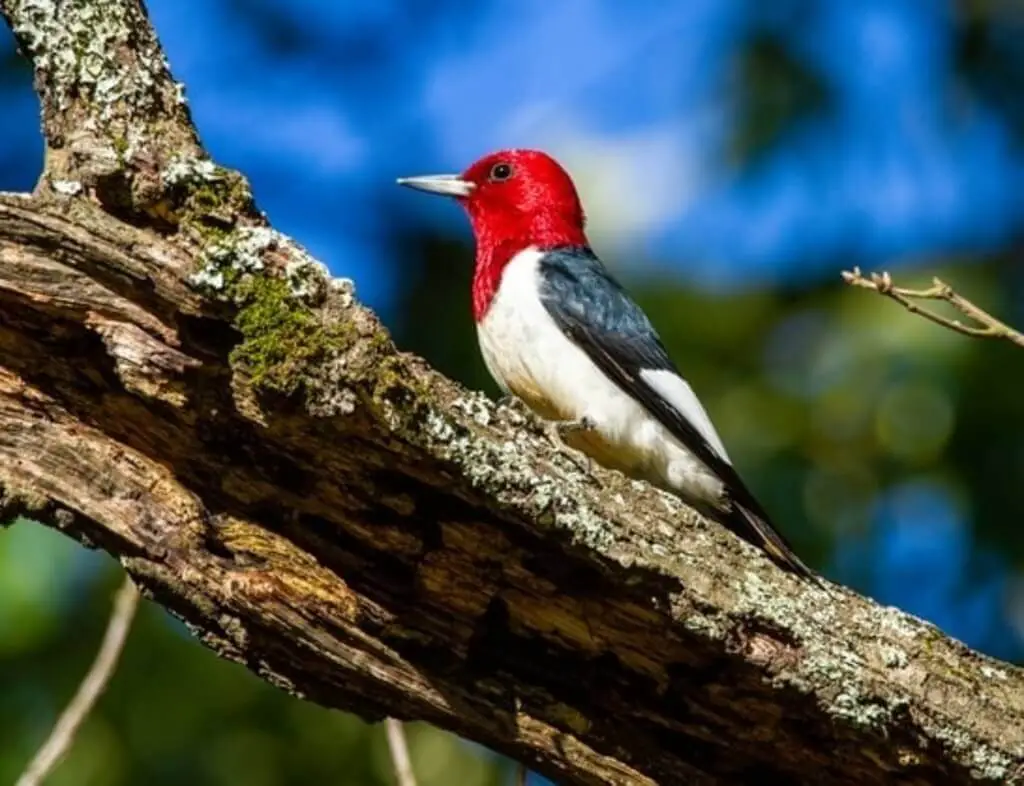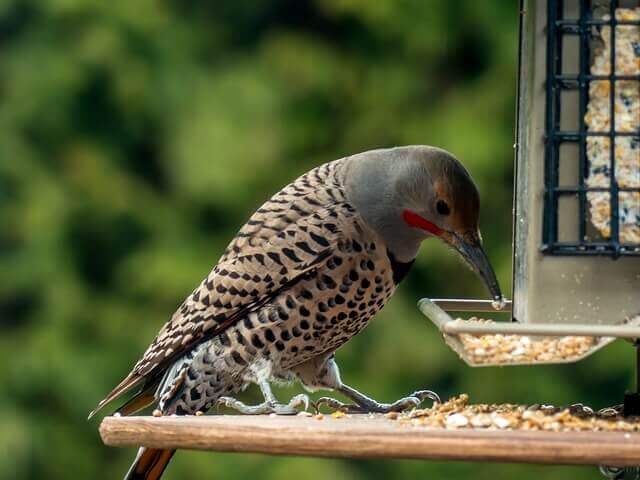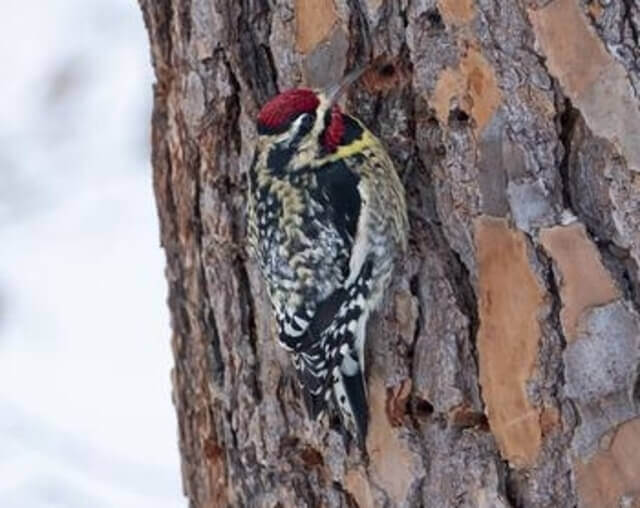Welcome to the captivating world of woodpeckers in Northern California, where 17 distinct species add splashes of color and rhythm to the region’s woodlands. Join us on a journey through lush forests as we uncover the fascinating lives of these remarkable birds.
Table of Contents
- 1 The Woodpeckers in Northern California
- 1.1 Nuttall’s Woodpecker
- 1.2 Northern Flicker
- 1.3 Acorn Woodpecker
- 1.4 Downy Woodpecker
- 1.5 Hairy Woodpecker
- 1.6 Red-breasted Sapsucker
- 1.7 White-headed Woodpecker
- 1.8 Pileated Woodpecker
- 1.9 Lewis’s Woodpecker
- 1.10 Ladder-backed Woodpecker
- 1.11 Red-naped Sapsucker
- 1.12 Yellow-bellied Sapsucker
- 1.13 Black-backed Woodpecker
- 1.14 Gila Woodpecker
- 1.15 Gilded Flicker
- 1.16 Red-headed Woodpecker
- 1.17 Williamson’s Sapsucker
- 2 Frequently Asked Questions
- 2.1 What is the largest woodpecker in Northern California?
- 2.2 Are there woodpeckers in Sacramento CA?
- 2.3 Are acorn woodpeckers native to California?
- 2.4 Are woodpeckers protected in California?
- 2.5 What is the smallest woodpecker in California?
- 2.6 Which is the most common woodpecker?
- 2.7 Where are acorn woodpeckers in California?
- 2.8 Where do woodpeckers live in California?
- 2.9 Are Downy Woodpeckers in California?
- 2.10 Is Woody Woodpecker an Acorn Woodpecker?
- 2.11 What is the largest woodpecker in California?
- 3 Author
The Woodpeckers in Northern California
Nuttall’s Woodpecker
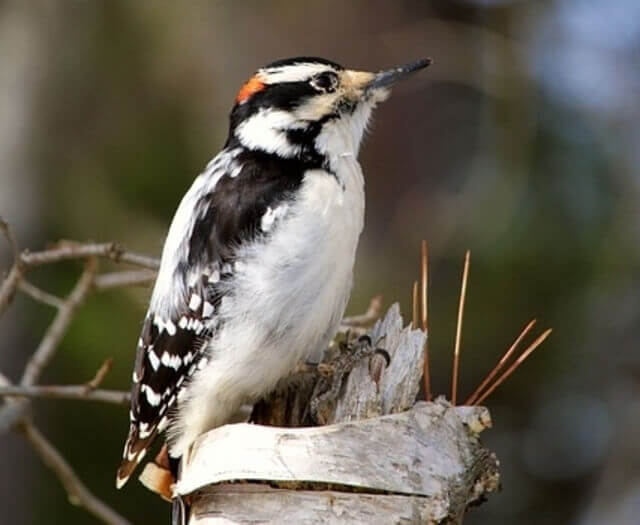
- Length: 6.3-7.1 in (16-18 cm)
- Weight: 1.1-1.6 oz (30-45 g)
- Wingspan: 13-16 in (33-40.6 cm)
- Frequency of Occurrence: 17.84% (Statistic by: eBird)
- Where To Find Them: In Northern California, they are most commonly seen in the higher elevations near the Sierra Nevada and Cascade mountain ranges.
- How to Attract: To create a suitable habitat for Nuttall’s woodpeckers, you should provide a mix of mature trees and shrubs along with some dead or decaying limbs. The birds will also need a source of water nearby. You can offer them food by placing a feeder filled with suet or insects in your yard.
Nuttall’s Woodpecker (Picoides nuttallii) is a medium-sized woodpecker that ranges from the Pacific Northwest to central Mexico. In the United States, Nuttall’s Woodpeckers are found in Oregon, Washington, California, Nevada, Utah, Colorado, New Mexico, and Texas.
They live in open woodlands and forests of Douglas-fir, ponderosa pine, white fir, red fir, and Lodgepole pine. Nuttall’s Woodpeckers forage on the ground or in trees for ants, beetle larvae, and other insects.
Northern Flicker
- Length: 11.0-12.2 in (28-31 cm)
- Weight: 3.9-5.6 oz (110-160 g)
- Wingspan: 16.5-20.1 in (42-51 cm)
- Frequency of Occurrence: 17.77%
- Where To Find Them: In California, it is most commonly seen in the foothills and mountains of the north state, but can also be found in the Sacramento Valley and along the coast.
- How to Attract: You can attract Northern Flickers to your backyard by providing them with a place to perch and by putting out food such as insect larvae, fruit, or bird seed. You can also purchase a nest box specifically for flickers and install it in a tree or on a post near your home.
The Northern Flicker (Colaptes auratus) is a medium-sized woodpecker found in North America and parts of Mexico. Northern Flickers are the most widely distributed woodpecker in the world. They can be found in a wide variety of habitats, including forests, open fields, open woodlands, forests, parks, and even suburban areas.
Northern Flickers eat a variety of foods, including insects, seeds, fruit, and sap. They are known to excavate their own nests in trees or use abandoned nests made by other animals. Northern Flickers typically mate for life and can live up to 10 years in the wild.
Acorn Woodpecker
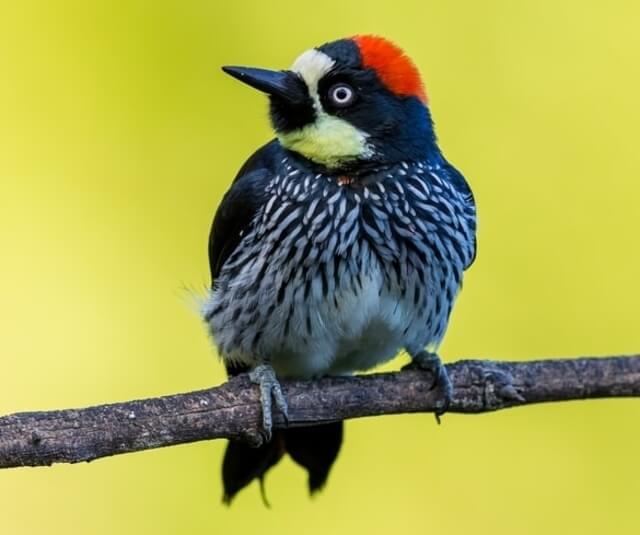
- Length: 7.5-9.1 in (19-23 cm)
- Weight: 2.3-3.2 oz (65-90 g)
- Wingspan: 13.8-16.9 in (35-43 cm)
- Frequency of Occurrence: 16.44%
- Where To Find Them: Acorn woodpeckers can be found in many areas of Northern California, including the Sacramento Valley, the Bay Area, and the Sierra Nevada foothills.
- How to Attract: One way to attract Acorn Woodpeckers is to provide a food source such as acorns. Oak trees are best for this, but other types of nut-bearing trees may also work. If there are no oak trees available, you can place a feeder filled with shelled nuts in an area where the birds are likely to visit. Another way to bring these woodpeckers closer is by putting up a nest box.
The Acorn Woodpecker is a species of woodpecker that is found in western North America. The range of the acorn woodpecker extends from British Columbia in Canada south to Baja California in Mexico, and east to the Great Plains.
The acorn woodpecker inhabits a variety of habitats, including forests, woodland, orchards, and parks. The diet of the acorn woodpecker consists mostly of acorns, but the bird will also eat insects and other small prey.
Downy Woodpecker
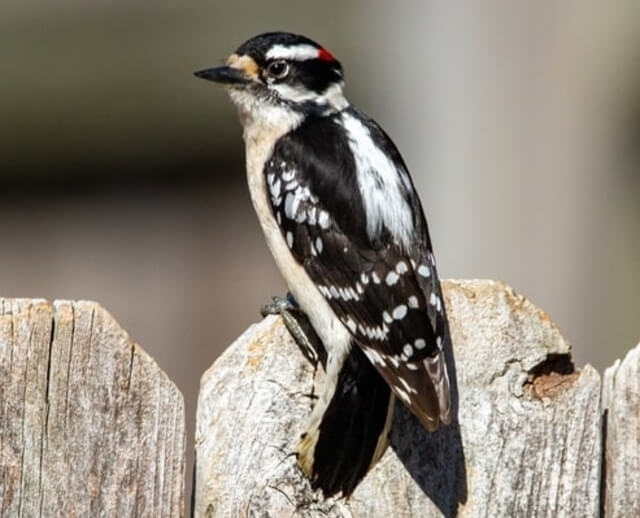
- Length: 5.5-6.7 in (14-17 cm)
- Weight: 0.7-1.0 oz (21-28 g)
- Wingspan: 9.8-11.8 in (25-30 cm)
- Frequency of Occurrence: 6.85%
- Where To Find Them: They are most common in the mountains and along the coast, but they can also be found in the Central Valley.
- How to Attract: You can attract them to your yard by putting up a bird feeder filled with black oil sunflower seeds or suet pellets. They can also be attracted to yards by adding a few dead trees or large branches to the landscape.
Downy Woodpeckers are the most common woodpecker in North America. They can be found in a variety of habitats, including forest edges, parks, residential areas, and even orchards. Downy woodpeckers eat a variety of things, including insects, nuts, seeds, and berries.
They forage on tree trunks and branches for food, using their sharp beaks to peck into bark and extract insects from tree bark or snag crevices with its long, sharp tongue. Downy woodpeckers are also known for their characteristic drumming noise, which they use to mark their territory.
Hairy Woodpecker
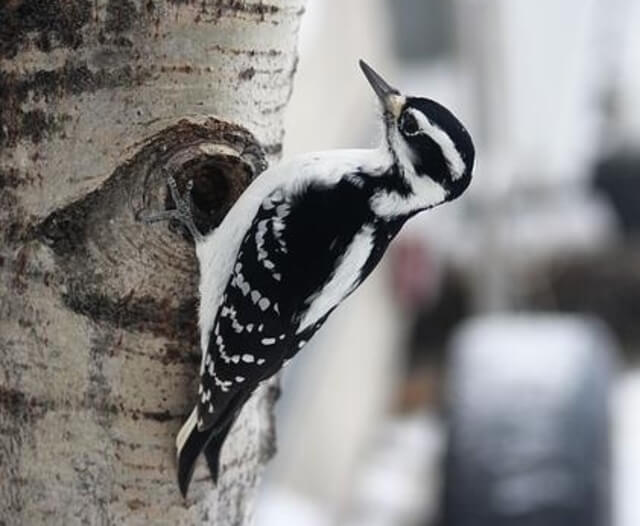
- Length: 7.1-10.2 in (18-26 cm)
- Weight: 1.4-3.4 oz (40-95 g)
- Wingspan: 13.0-16.1 in (33-41 cm)
- Frequency of Occurrence: 4.25%
- Where To Find Them: In California, they are mostly found in the north, but can be seen as far south as San Diego County.
- How to Attract: There are a few things you can do to attract these birds to your yard. One is to provide them with a place to nest. You can do this by putting up a nest box, or by drilling holes in a tree trunk. Another way to attract these birds is by putting out food for them. You can do this by putting out a bird feeder, or by scattering some seeds on the ground.
The Hairy Woodpecker is found in North America and parts of South America. They are most commonly found in the boreal forests of Canada and the United States. A small number of Hairy Woodpeckers also live in tropical regions of Central America and South America. The Hairy Woodpecker lives in a variety of habitats, including forests, woodlands, parks, and gardens.
They prefer to live in areas with tall trees that have plenty of dead or decaying wood for them to search for food. Hairy Woodpeckers eat mostly insects, although they will also eat fruit, nuts, and seeds. They catch insects by pecking on tree trunks and branches to find hidden bugs.
Red-breasted Sapsucker

- Length: 7.9-8.7 in (20-22 cm)
- Weight: 1.9-2.2 oz (53.1-63.5 g)
- Wingspan: 14.6-16.0 in (37-40.6 cm)
- Frequency of Occurrence: 2.20%
- Where To Find Them: In California, they are typically seen in the higher elevations near the Sierra Nevada and Cascade mountain ranges.
- How to Attract: There are several ways to attract red-breasted sapsuckers to your backyard. One way is to provide them with a suet feeder filled with a suet cake or peanut butter. You can also hang a feeder filled with sunflower seeds or black oil sunflower seeds. Another way to attract these birds is to plant a few fruit trees in your yard, such as apple, cherry, or plum trees. The red-breasted sapsucker will feast on the insects that are attracted to these fruit trees.
The Red-breasted Sapsucker is a medium-sized woodpecker that ranges throughout much of North America. They inhabit forested areas and prefer to live near water. These birds are omnivorous and feed on a variety of items, including insects, berries, and sap from trees.
They use their distinctive bill to drill holes in trees in order to extract sap, which they then eat. Red-breasted sapsuckers are also known for their loud vocalizations, which can be heard from some distance away.
White-headed Woodpecker
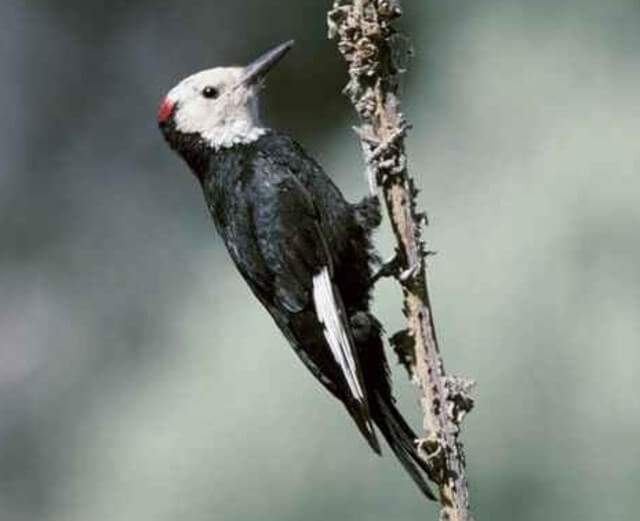
- Length: 7.9-9.1 in (20-23 cm)
- Weight: 1.9-2.3 oz (55-65 g)
- Wingspan:16.9 in (43 cm)
- Frequency of Occurrence: 1.04%
- Where To Find Them: They can be found in the higher elevations of the Sierra Nevada and Cascade mountain ranges, as well as in the redwood and Douglas fir forests along the coast.
- How to Attract: First, make sure you have a variety of trees and shrubs in your yard. The white-headed woodpecker likes to feed on insects that are hidden in the bark of trees. They also like to find food by drilling into dead tree limbs. So having plenty of trees and shrubs will give them plenty of places to look for food. Second, put out some bird feeders. These birds love to eat suet, sunflower seeds, and peanuts.
The White-headed Woodpecker is a medium-sized black and white woodpecker found in eastern North America. They are usually found in deciduous forests, but can also be found in mixed pine and hardwood forests, and urban areas. These birds eat insects, especially ants, as well as acorns, nuts, and berries.
They forage on the trunks and branches of trees, often hammering on the wood to find food. White-headed woodpeckers breed in the spring, laying 3-4 eggs in a cavity in a tree. The young birds stay with their parents for several months after hatching.
Pileated Woodpecker
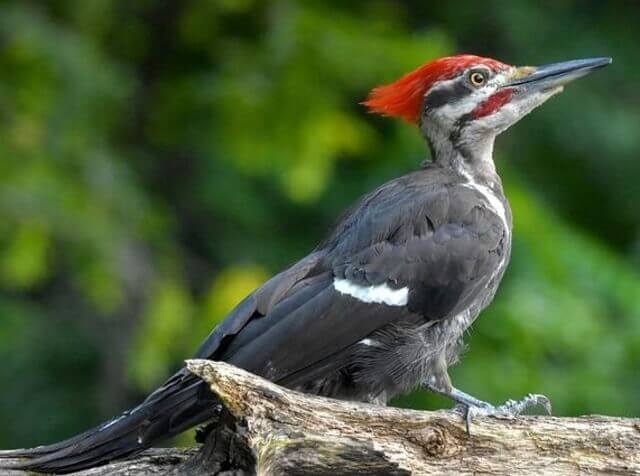
- Length: 15.8-19.3 in (40-49 cm)
- Weight: 8.8-12.3 oz (250-350 g)
- Wingspan: 26.0-29.5 in (66-75 cm)
- Frequency of Occurrence: 0.9377%
- Where To Find Them: In California, it is found in coniferous and mixed forests in the north, and along the Sierra Nevada and Cascade ranges.
- How to Attract: Pileated woodpeckers can be attracted to backyards by putting out suet feeders or put out a lot of insect-rich bark, or nesting boxes.
The Pileated Woodpecker is one of the most easily identifiable woodpeckers in North America. They are a large, black and white woodpecker with a characteristic red crest. Pileated woodpeckers range throughout much of the eastern United States and southern Canada.
The Pileated Woodpecker can be seen in oak woodlands, mixed coniferous forests, and riparian habitats. This woodpecker is often seen near water sources, such as rivers and streams. Pileated woodpeckers feed on a variety of insects and other invertebrates, as well as fruit and nuts. They often forage on the ground, but will also search for food on trees.
Lewis’s Woodpecker

- Length: 10.0-11.0 in (25.4-28 cm)
- Weight: 3.0–5.0 oz (88–139 g)
- Wingspan: 19.3–20.5 in (49–52 cm)
- Frequency of Occurrence: 0.5903%
- Where To Find Them: The areas they are seen in are the Redwood National and State Parks, Jedediah Smith Redwoods State Park, and Humboldt Lagoons State Park. They can also be found in Del Norte Coast Redwoods State Park, Prairie Creek Redwoods State Park, and Richardson Grove State Park.
- How to Attract: To attract these birds, you can provide a feeder with suet or peanut butter. You can also place a log or platform near your feeder for the birds to perch on. Dead trees can be enhanced by leaving some branches intact and putting up a nesting box.
Lewis’s Woodpecker is found in western North America. Its range extends from southern British Columbia in Canada south through the western United States to Baja California in Mexico. The Lewis’s Woodpecker inhabits a variety of habitats, including open woodlands, coniferous forests, riparian corridors, and oak and pine woodlands.
This bird is typically found near water and frequently forages in trees adjacent to streams and ponds. Lewis’s Woodpeckers eat a variety of insects, including ants, beetles, caterpillars, bees, wasps, and spiders. They also consume fruit and nuts.
Ladder-backed Woodpecker
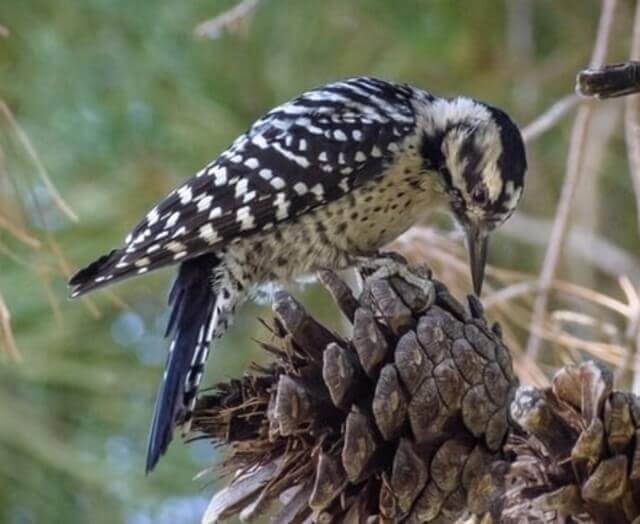
- Length: 6.3-7.1 in (16-18 cm)
- Weight: 0.7-1.7 oz (21-48 g)
- Wingspan: 13.0 in (33 cm)
- Frequency of Occurrence: 0.5651%
- Where To Find Them: The ladder-backed woodpecker is a common bird in the oak woodlands and chaparral of Northern California. They can be seen along the coast and in the Sierra Nevada foothills.
- How to Attract: The ladder-backed woodpecker is a common backyard bird that can be attracted to a backyard feeder by providing suet, peanut butter, and sunflower seeds. The best way to attract these birds is by placing the feeder in an open area near a tree or large shrub. Ladder-backed woodpeckers will also visit bird baths, so it is a good idea to provide one that is shallow and has a rough surface for them to bath in.
The Ladder-backed Woodpecker is a small bird that is found in the southwestern part of the United States. The bird ranges from Texas to California and can also be found in parts of Mexico.
The Ladder-backed woodpecker prefers habitats that have a lot of trees, such as forests and woodlands. The diet of the Ladder-backed woodpecker consists mainly of insects, but the bird will also eat berries and seeds.
Red-naped Sapsucker
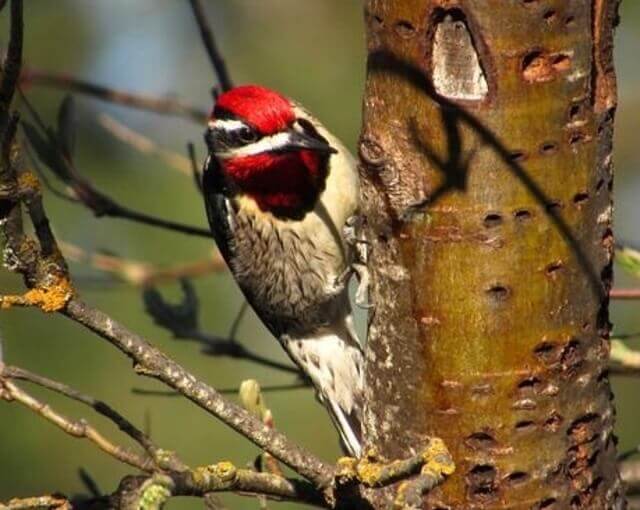
- Length: 7.9-8.7 in (20-22 cm)
- Weight: 1.9-2.2 oz (53.1-63.5 g)
- Wingspan: 14.6-16.0 in (37-40.6 cm)
- Frequency of Occurrence: 0.2078%
- Where To Find Them: The Red-naped Sapsucker is not common in Northern California, but can be found in moist forested areas near the coast as well as in the Sierra Nevada foothills.
- How to Attract: One way to attract Red-naped Sapsuckers is to put up a suet feeder. They love suet, which is a high-fat food made from animal fat. You can also put out a hummingbird feeder or a feeder filled with fruit. If you live in an area where these birds are common, you may also want to try putting out a few logs for them to peck at.
The Red-naped Sapsucker is a North American woodpecker that ranges from southern Alaska to central Mexico. They can be found in forests and woodlands across Canada and the United States.
These sapsuckers prefer coniferous forests and live in a variety of habitats including evergreen and deciduous forests, riparian zones, and woodlands.They forage for insects on tree trunks and branches, as well as on the ground. Their diet includes insects, spiders, fruit, and sap from trees.
Yellow-bellied Sapsucker
- Length: 7.1-8.7 in (18-22 cm)
- Weight: 1.5-1.9 oz (43-55 g)
- Wingspan: 13.4-15.8 in (34-40 cm)
- Frequency of Occurrence: 0.1086%
- Where To Find Them: In California, they can be found in Redwood National Park, Lassen Volcanic National Park, and other parks in the northern part of the state.
- How to Attract: If you want to attract these birds to your yard, there are a few things you can do.
One thing you can do is put up a bird feeder. These birds love to eat insects, so putting out a feeder that has suet or peanut butter will attract them. You can also hang up some fruit in your yard, such as grapes or raspberries. Another thing you can do is provide some water for the birds to drink. A simple bird bath will work, or you can also create a small pond in your yard.
The Yellow-bellied Sapsucker is a medium-sized woodpecker found in eastern North America. They range from southern Canada to northern Florida, and west to Texas. They inhabit deciduous forests and mixed woods, as well as parks and suburban areas.
Yellow-bellied sapsuckers feed on sap from trees, as well as insects and fruit. They often forage in flocks, and can be seen flying from tree to tree in search of food.
Black-backed Woodpecker
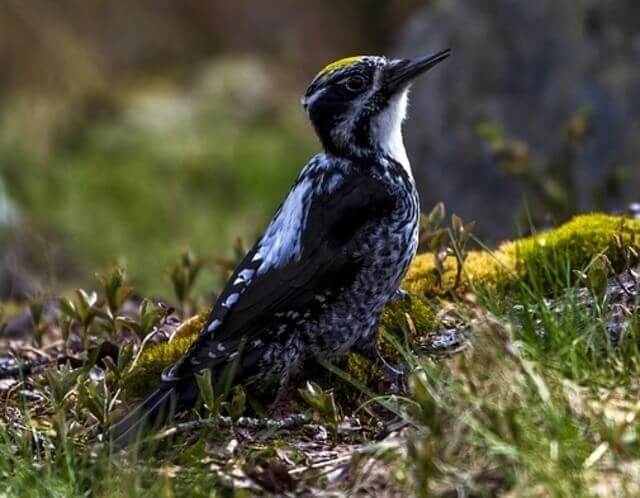
- Length: 9.1 in (23 cm)
- Weight: 2.1-3.1 oz (61-88 g)
- Wingspan: 15.8-16.5 in (40-42 cm)
- Frequency of Occurrence: 0.0853%
- Where To Find Them: In the northern part of the state, they are most often seen in the higher elevations around Yosemite National Park. They can also be found in the Sierras and along the North Coast.
- How to Attract: Black-backed woodpeckers are beautiful and interesting birds that can be easily attracted to a backyard feeder with the right food. In the wild, they primarily eat insects, but at a backyard feeder they will also eat suet, sunflower hearts, and peanut hearts. To attract black-backed woodpeckers to your backyard, provide a mix of these foods in a feeder or platform feeder that is located near trees. You can also put up a bird house in an appropriate tree nearby to provide additional shelter for these birds.
The Black-backed Woodpecker is found in the western United States and parts of Canada. Their range extends from the Pacific Coast to the Rocky Mountains, and they can also be found in parts of the Northeast. Black-backed woodpeckers inhabit a variety of habitats, including coniferous forests, mixed forests, and deciduous forests.
These birds are mostly found in forested areas, but they can also be seen in open fields and meadows. Black-backed woodpeckers forage on a variety of food items, including insects, spiders, fruit, nuts, and seeds.
Gila Woodpecker
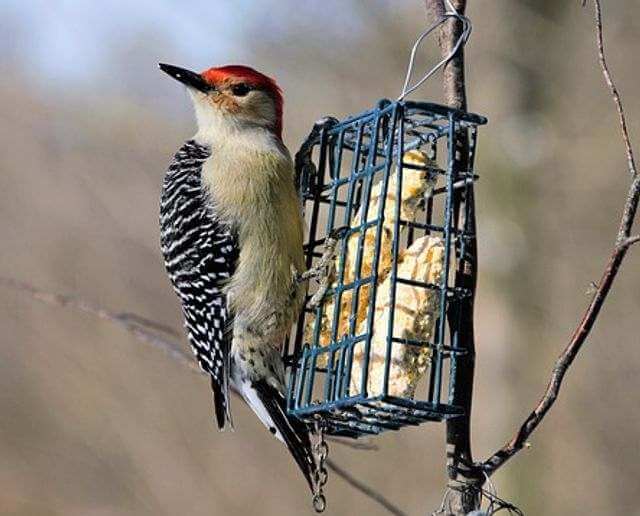
- Length: 8.7-9.4 in (22-24 cm)
- Weight: 1.8-2.8 oz (51-79 g)
- Wingspan: 15.8-16.5 in (40-42 cm)
- Frequency of Occurrence: 0.0839%
- Where To Find Them: In California, they are most commonly seen in the higher elevations of the Sierra Nevada and the southern Cascades. They are also occasionally seen in the Coast Ranges and the Central Valley.
- How to Attract: If you want to attract a Gila Woodpecker to your backyard, you should provide them with a dead tree or other large object to nest in, as well as some supplemental food. You can provide them with food by putting out feeders filled with suet or peanut butter, or by scattering birdseed on the ground.
The Gila Woodpecker is a medium-sized woodpecker that is found in the southwestern United States and northwestern Mexico. Its range extends from southern California to central Texas and from western Arizona to eastern New Mexico. The Gila Woodpecker inhabits a wide variety of habitats, including desert scrub, piñon-juniper woodland, ponderosa pine forest, and oak woodland.
It forages on the ground for insects and also climbs trees to find food. The diet of the Gila Woodpecker includes ants, beetles, caterpillars, grasshoppers, wasps, and other insects.
Gilded Flicker
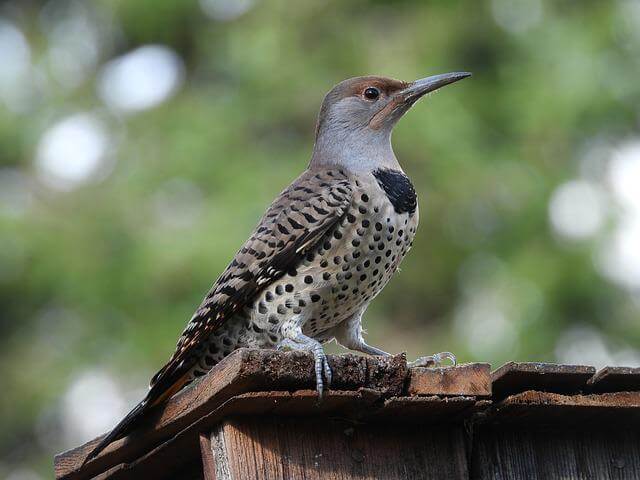
- Length: 11.0 in (28 cm)
- Weight: 3.3-4.5 oz (92-129 g)
- Wingspan: 19.7-20.5 in (50-52 cm)
- Frequency of Occurrence: 0.0050%
- Where To Find Them: It is found in open woodlands and riparian corridors from the foothills of the Sierra Nevada Mountains to the Central Valley.
- How to Attract: One way to attract these birds is by providing them with a bird bath. Gilded Flickers love to take baths and will visit your backyard if they see a suitable place to bathe. You can also provide them with food by putting out a feeder filled with sunflower seeds or suet. Finally, make sure you have some trees or other plants in your yard that the Gilded Flickers can use for nesting and hiding from predators.
The Gilded Flicker is a North American woodpecker found in open and semiopen areas in the western United States and Mexico. The Gilded Flicker ranges from southern British Columbia in Canada to Baja California Sur in Mexico.
In the east, its range extends as far south as Zacatecas and San Luis Potosi in Mexico. The Gilded Flicker inhabits open woodlands, parks, orchards, and agricultural land. It forages on the ground for ants, beetles, and other insects.
Red-headed Woodpecker
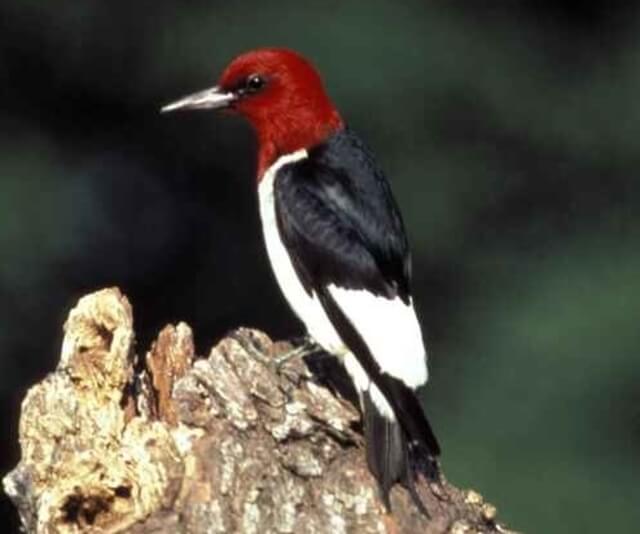
- Length: 7.5-9.1 in (19-23 cm)
- Weight: 2.0-3.2 oz (56-91 g)
- Wingspan: 16.5 in (42 cm)
- Frequency of Occurrence: 0.0001%
- Where To Find Them: One great spot for finding red-headed woodpeckers is in the Plumas National Forest. This forest is located in the northeastern corner of the state and is home to a large population of these birds. The forest has a wide variety of habitats, including coniferous forests, oak woodlands, and riparian areas. Another great place to see red-headed woodpeckers is along the Sacramento River.
- How to Attract: You can attract red-headed woodpeckers to your backyard by providing them with a food source and a place to nest. They love to eat insects, so you can attract them by putting out a bird feeder filled with insect-rich food like suet or mealworms. You can even offer them a nesting box.
The Red-headed Woodpecker is common in eastern North America, from southeastern Canada to Florida and west to Texas. It is also distributed throughout some regions of central and South America. These woodpeckers are usually found in deciduous forests, but they can also be seen in parks, gardens, and other areas with large trees.
Red-headed Woodpeckers eat mainly insects, but they will also eat fruit, seeds, and nuts. They mostly search for food on the ground or in dead trees, but they will also climb live trees to find food.
Williamson’s Sapsucker

- Length: 7.1-8.7 in (18-22 cm)
- Weight: 1.5-1.9 oz (43-55 g)
- Wingspan: 13.4-15.8 in (34-40 cm)
- Frequency of Occurrence: 0.2661%
- Where To Find Them: In California, they are found primarily in the coniferous forests of the Sierra Nevada and Cascade mountain ranges.
- How to Attract: Williamson’s Sapsuckers like to feed on the sap of trees, so if you want to attract these birds to your yard, you will need to provide them with some trees that have high sap levels. You can also hang suet or other bird feeders in your yard.
Williamson s Sapsucker (Sphyrapicus thyroideus) is a medium-sized woodpecker found in North America. They are generally found in coniferous forests, but can also be found in deciduous forests. Williamson s Sapsuckers range from British Columbia to Mexico, and east to Minnesota and North Carolina. They prefer open areas with large trees for foraging.
Their diet consists mostly of insects, but they will also eat fruit, sap, and nuts. Williamson s Sapsuckers use their specially adapted bills to drill into tree bark and extract sap. This feeding behavior is how they got their name. They are the only woodpecker in North America that specializes in feeding on sap.
Frequently Asked Questions
What is the largest woodpecker in Northern California?
The Pileated Woodpecker takes this title, with its striking red crest and impressive size, making it a captivating presence in Northern California’s woodlands.
Are there woodpeckers in Sacramento CA?
Absolutely! Sacramento is home to various woodpecker species, adding lively bursts of color and sound to the city’s natural spaces.
Are acorn woodpeckers native to California?
Yes, indeed. Acorn Woodpeckers are native Californians, recognizable by their unique facial patterns and acorn storage habits, often found in oak-rich regions.
Are woodpeckers protected in California?
Yes, woodpeckers are protected in California, as they play vital roles in ecosystem balance and are safeguarded by wildlife conservation laws.
What is the smallest woodpecker in California?
The Downy Woodpecker claims this title, boasting a petite yet charismatic presence in California’s diverse habitats.
Which is the most common woodpecker?
The Acorn Woodpecker holds the title for the most common woodpecker in Northern California, known for its communal lifestyle and characteristic ‘acorn trees.’
Where are acorn woodpeckers in California?
Acorn Woodpeckers thrive in wooded areas, particularly oak-rich regions, making places like Yosemite and coastal woodlands their preferred habitats.
Where do woodpeckers live in California?
Woodpeckers are adaptable and can be found in various habitats across California, from forests to urban areas, wherever suitable trees for foraging and nesting are present.
Are Downy Woodpeckers in California?
Yes, Downy Woodpeckers are present in California, with their distinctive black-and-white plumage and small size making them a delightful sighting.
Is Woody Woodpecker an Acorn Woodpecker?
No, Woody Woodpecker, a fictional character, doesn’t represent a specific woodpecker species. He’s a creation of animation, not a real bird.
What is the largest woodpecker in California?
The Ivory-billed Woodpecker, although considered extinct or extremely rare, holds the title for the largest woodpecker historically in California. Following closely is the Pileated Woodpecker, another impressive species recognized for its striking appearance and size in the state’s woodlands.

